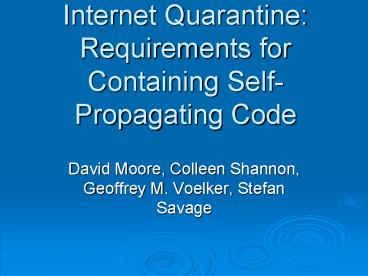Internet Quarantine: Requirements for Containing Self-Propagating Code - PowerPoint PPT Presentation
Title:
Internet Quarantine: Requirements for Containing Self-Propagating Code
Description:
How effectively can any containment approach counter a worm epidemic on the ... La Brea. Intercept worm and place it in artificial persistent connection state ... – PowerPoint PPT presentation
Number of Views:33
Avg rating:3.0/5.0
Title: Internet Quarantine: Requirements for Containing Self-Propagating Code
1
Internet QuarantineRequirements for Containing
Self-Propagating Code
- David Moore, Colleen Shannon, Geoffrey M.
Voelker, Stefan Savage
2
Worm Security
- Prevention
- Stop the worms from propagating by eliminating
security holes from software infeasible - Treatment
- Remove the worm from the infected host
- Containment
- Stop the worm from spreading
3
Worm Containment
- How effectively can any containment approach
counter a worm epidemic on the Internet? - Time to detect
- Identification and containment
- Deployment
4
Background
- History of Worms
- First appeared in 1988
- Few studies done on worms
- Worm containment approaches
- La Brea
- Intercept worm and place it in artificial
persistent connection state - Unclear how effective it is
- Per-host throttling
- Reduce the rate of new connections allowed
- If universally deployed, can reduce worm spread
- Firewall filters
- Detect worms then cut off communications using
firewalls to block ports - NBAR
- Developed by Cisco
- Allows routers to block TCP sessions based on
presence of certain strings in the session
5
Modeling Worms
- Classic SI model
6
SI Model
- Susceptible (S), Infected (I), population (N),
contact rate (beta) - dI/dt betaIS/N
- dS/dt -betaIS/N
- Solving (T as a constant of integration)
- i(t) (e(beta(t-T)))/(1e(beta(t-T)))
- Grows exponentially until majority are infected
- Well known in public health community
7
Modeling Containment
- Reaction Time
- The time R in which the system can react to
contain the worm - Containment Strategy
- Address Blacklisting
- Block traffic from malicious source IPs
- Reaction relative to each host
- Content Filtering
- Block traffic based on content
- Reaction time from first infection
- Deployment Scenario
- Analyzed a few different deployment scenarios in
the model - Finite Time Period
- Restricted to looking at first 24 hours after
worm appears
8
Idealized Deployment
- Simulation Parameters
- Code-Red Case Study
- Generalized Worm Containment
9
Simulation Parameters
- 360,000 vulnerable hosts
- Probe rate of 10 per second
- Probes randomly from time t 0
- Hosts notified of infected hosts at t R
10
Code-Red Case Study
- Address blacklisting
- Containment with R lt 20 minutes
- Larger R allows spread
- All susceptible hosts infected in 24 hours if R gt
2 hours - Content Filtering
- Containment with R lt 2 hours
- Worm propagates until t R, then stops
11
Modeling the Worm
- Graphs Reaction time to the percentage of
vulnerable hosts infected in the 24 hour
time-period analyzed
12
Generalized Worm Containment
- Content Filtering vs. Address Blacklisting
- Highly aggressive worms
- Extremely challenging, even for content filtering
- 1000 probes/sec requires R 2 min
13
Practical Deployment
- Far more limited
- Network Model
- Deployment Scenarios
- Code-Red Case Study
- Generalized Worm Containment
14
Network Model
- Identify ASes on the Internet
- Identify vulnerable hosts and their locations
- Model AS paths between vulnerable hosts
15
Deployment Scenarios
- Models levels of AS deployment of containment
16
Code-Red Case Study
- Uses same parameters as idealized model
- Reaction time 2 hours
17
Generalized Worm Containment
- Much smaller containment with network model
- 100 top ISPs model
- 50 customers model
- Worse results than 100 top ISPs
- Infeasible to contain even modest probe rates
under these models
18
Deployment Scenarios
19
Conclusion
- Very challenging to build containment systems
- Order of minutes needed to respond effectively
- In the future, worms will be more aggressive
- Will require a great amount of effort and
engineering to fight the spread of Worms.





![Automated Worm Fingerprinting [Singh, Estan et al] Internet Quarantine: Requirements for Self-Propagating Code [Moore, Shannon et al] PowerPoint PPT Presentation](https://s3.amazonaws.com/images.powershow.com/6090138.th0.jpg?_=20150207110)

























